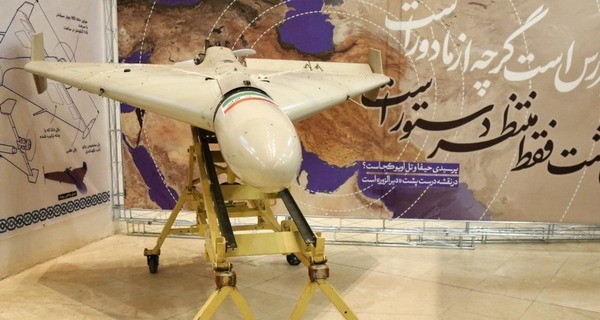Kyiv, Ukraine – A Russian man who recorded a heavy drone that crashed in a field near the western Russian village of Shirinka was ecstatic.
In a video shared online on May 26, the unnamed man claimed the white drone was Ukrainian and carried “missiles”.
German military analyst Julian Roepke identified the drone as a malfunctioning heavy, Iranian-made Mohajer-6 drone.
“Iranian military support for Russia is at a new level,” he posted on X.
The crash landing presented a troubling surprise for Ukraine.
The supposed “missiles” on the crashed drone were precision-guided aerial bombs intended for the northern Ukrainian region of Sumy, analyst Roepke explained.
Tehran supplies these bombs to Moscow along with cheaper, slower Shahed “kamikaze” drones, artillery shells, and reportedly ballistic missiles. Observers believe these are exchanged for Russia’s international support and advanced weaponry that could defend Iran from potential Israeli and US attacks.
Since 2022, Shahed drones have served as “substitute cruise missiles,” enabling Moscow to carry out frequent, large-scale attacks on energy infrastructure and civilian areas, according to Ukrainian military analyst Mykhailo Zhirokhov.
“In the fall of 2022, Russians nearly succeeded in plunging the entire country into darkness using these drones,” Zhirokhov told.
The sight and sound of Shahed drones terrified Ukrainians, bringing destruction to millions of homes.
“I thought I saw my death,” retired nurse Oleksandra Kozodub told, recalling a white, triangular Shahed she saw in central Kyiv during the first major drone attack in October 2022.
“I just sat on the ground and watched it fly by,” she said about the attack that killed six people, including a pregnant woman.
In numerous subsequent attacks, swarms of drones killed hundreds, destroyed power stations, and damaged residential buildings.
US national security adviser Jake Sullivan stated that Tehran’s arms could make Iran complicit in widespread war crimes.
Kyiv accused Tehran of sending Islamic Revolutionary Guard Corps members to Russian-occupied Ukrainian regions to train Russian troops on launching Shahed drones.
“We strongly deny this news,” Nasser Kanani, an Iranian foreign ministry spokesman, said on October 24, 2022, as quoted by AFP.
However, weeks later in November, Ukrainian intelligence claimed to have killed 10 such instructors in annexed Crimea.
Ukrainians quickly learned to shoot down Shahed drones with assault rifles and advanced Western air defense systems.
They derisively nicknamed them “mopeds” for their slow speed and the sound they make.
But Russia started assembling hundreds of modified Shaheds, named Gerans, near the western Russian city of Yelabuga.
These drones are painted black for lower visibility and equipped with Russian-made Kometa-M antennas to counter radio-electronic jamming.
In April, Ukraine targeted the Yelabuga plant with long-range drones.
Protokol, an independent Russian media outlet, reported in July 2023 that Russian college students are forced to assemble drones at the factory, working long shifts without breaks alongside young women hired from Uganda, Ethiopia, and Tanzania.
Shahed and Geran drones overwhelm Western-supplied air defense systems, forcing Kyiv to use costly missiles on them, after which the Russians launch faster, more destructive cruise missiles.
“Unfortunately for us, [Shaheds] are a threat we’re dealing with – rather effectively,” Lieutenant General Ihor Romanenko, former deputy chief of Ukraine’s General Staff of Armed Forces, told. “But they still penetrate, strike, and kill people.”
He compared the swarms of Shaheds to “meat marches,” or frontal assaults by hundreds of Russian soldiers to find weak points in Ukrainian defenses.
“They’re meat marches in the sky,” Romanenko said.
Russia’s use of Mohajer drones has mostly been limited to air patrols and guiding strikes over the Black Sea.
Equipped with infrared target seekers and a televised guidance system, the Qaem-5 bombs, weighing up to 25kg, can glide up to 40km (25 miles) towards their target using six small wings.
But experts doubt they will significantly change the war.
Russia already uses much heavier, domestically manufactured gliding bombs to destroy Ukraine’s most fortified defenses.
These weapons have led to the recent capture of several towns in eastern Ukraine.
The use of smaller Iranian bombs might be limited to targeting tanks, suggested a military analyst from Germany’s Bremen University.
“Which [bombs] are better will become clear based on their frontline results,” Nikolay Mitrokhin told.
Iran has also supplied the Russian military with limited numbers of 152mm artillery shells and 120mm mortar mines, analyst Zhirokhov said.
“However, according to Russian military feedback, this ammunition’s quality was subpar,” he said.
Ukraine’s military shared this view after receiving some intercepted Iranian-made ammunition intended for Yemen’s Houthi rebels from the US, he said.
Reuters reported in February, citing Iranian military sources, that Tehran provided Russia with around 400 surface-to-surface missiles with a range of up to 700km (435 miles).
Ukrainian President Volodymyr Zelenskyy supported this claim, saying that Iran supplies “not just drones, but missiles too”.
To some observers, Tehran seems to be prioritizing quantity over quality. Iran is receiving advanced Russian Su-35 fighter jets, helicopters, and sophisticated air defense systems that it hopes can intercept potential Israeli or even US missiles.
Tel Aviv has long urged Moscow not to sell S-300 air defense complexes to Iran.
In 2009, Israel’s then-president, Shimon Peres, told this reporter that he visited Russia to persuade the Kremlin to halt the supply, as it might affect “the delicate balance in the Middle East”.
Tehran received the S-300s only after agreeing with Washington to limit its nuclear program in 2015.
Nowadays, Iran may acquire far more advanced S-400 systems that can target planes or missiles up to 250 kilometers (155 miles) away and be reprogrammed to hit ground targets.
However, the S-400’s invincibility has been questioned as they fail to protect themselves.
Ukrainian intelligence claims that from May 2023 to May 2024, Kyiv destroyed or damaged half a dozen S-400 complexes in Crimea, occupied parts of Ukraine, and western Russia using US-made ATACMS missiles and Ukrainian Neptune missiles.
Meanwhile, Iran has become a crucial part of the Russia-China alliance and Beijing’s trade routes across Eurasia, Kyiv-based analyst Aleksey Kushch told.
“Iran is a key nation that connects the new north-south route and the new version of the Great Silk Road from China,” he said.








